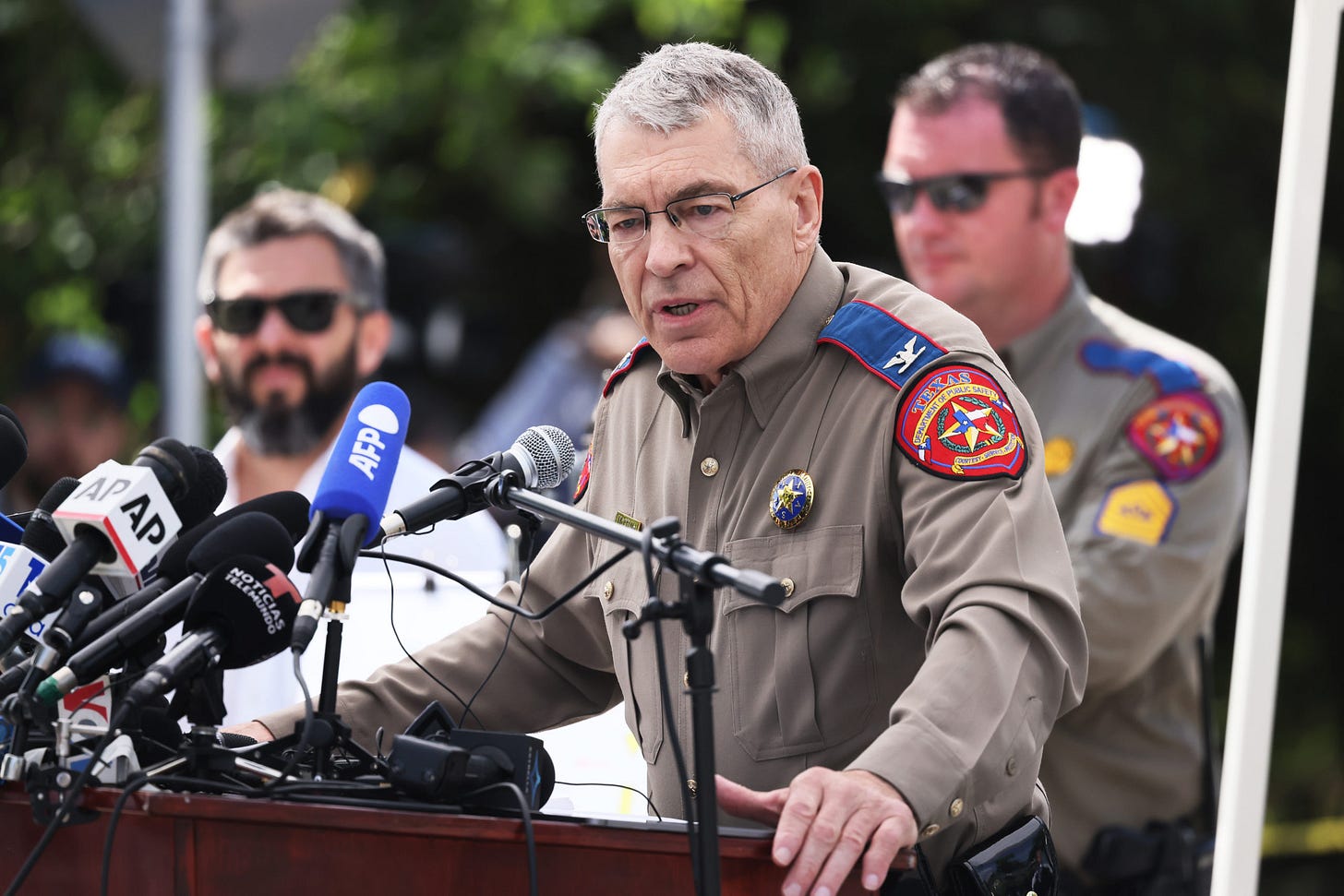In Uvalde, the Most Enraging Press Conference in American History
We cannot count on flawed cops and school resource officers to protect kids from teenagers with assault rifles.

What might very well be the most enraging press conference in American history just ended in Uvalde, Texas.
Texas Department of Public Safety Director Steve McCraw revealed that there were 19 officers in the school hallway for about an hour as small children used their deceased teacher’s phone to dial 911 and beg for their lives. He described local police officials preventing border patrol and other federal law enforcement who had arrived on the scene from entering the school and helping these terrorized kids, while their keening parents begged them to act. He acknowledged the school resource officer was not on the scene.
And after admitting this staggering level of incompetence in the face of unimaginable evil—a failure so immense that it will reverberate for generations—McCraw said dismissively, “If I thought it would help, I’d apologize.”
I want to throw my computer through a wall just transcribing these words.
McCraw followed that remark by making a rather revealing point. In defense of the officers on scene he said that there was “a barrage—hundreds of rounds were pumped in four minutes into those classrooms.”
Hundreds of rounds. Four minutes. When you cut away all the bullshit, and excuse making, and failure this is the crux of the matter.
In the coming days there will be a desire to obsess only over the unfathomable failures of those who were charged with keeping these kids safe. The poor teacher who left a door ajar. The MIA resource officer. The cops, excuse me—the SWAT Team—that posed on Facebook in tactical gear with weapons of war looking like they were prepared to head to the Donbas, but were apparently unequipped to take on a lone teenager who was slaughtering their town’s children.
But the main thing to take away from all of that is not that their failure can be reversed. It’s that in a nation with 130,000 schools there will always be some kind of human error when responding to an active shooter. God willing those errors won’t be as catastrophic as they were in Uvalde. But there will always be errors.
Parkland had an armed officer and the single point of entry that the “door control” crowd is now so obsessed with. Sandy Hook was breached by the killer firing through a window next to a locked security door. Santa Fe High School in Texas had put in place a school shooting plan with armed officers, before 10 were killed.
Can we develop better procedures for dealing with shooters in school? Probably. Schools have been wargaming these scenarios for years already, though. And yes, we can and should provide more funding for schools to help make them safer.
But when a child is able to access two assault rifles and hundreds of rounds of bullets—and are able to massacre a dozen innocents in the blink of an eye—then there is no level of door control or resource officer training that can reliably stop them.
There will always be a teacher or a kid who leaves a door open. There will always be a resource officer who is outmatched by the child Rambo with a military arsenal. There will always be a moment where kids are moving between classes, or to lunch, or to chapel, or to the football game, or to the bus and where all of the carefully designed safety precautions fall apart. And yes, there will always be fallible police officers scared for their own lives making split second—or in this case 3,600 seconds—calculations revealing that they are unfit for duty and should not be entrusted by their communities with all of that unused tactical gear.
So yes, absolutely, we should do anything in our power to make schools safer.
But the important takeaway from Uvalde shouldn’t be that next time we just need perfect cops, and unimpeachable protocols, and more competent “good guys with guns.” Time after time we’ve seen that this isn’t possible in the real world. The military understands that plans rarely survive first-contact with the enemy. The fetishists insisting that “guns don’t kill people, doors do,” do not.
The only way to actually protect these kids is to make it harder for their peers to get the deadly weapons that have allowed so many shooters to evade so many cops and so many safety procedures.


